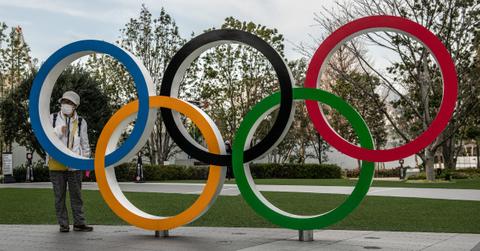Find out the Symbolic Meaning Behind the Iconic Olympic Rings
Updated Feb. 9 2022, 4:12 p.m. ET

Though some sports have changed and been added throughout the years, one constant at the Olympics is the symbolic rings. The five multicolored interlocking ovals have become synonymous with the prestigious event, so much so that they alone could stand in place of the event's name and most fans would know what was going on.
So, what do these rings represent? Who created this symbol? Keep reading to find out more about the iconic Olympic rings.

What is the meaning behind the Olympic rings? Why are there only five rings?
Though the first Olympic Games were held in 1896, the symbolic rings were not created until 1913. Pierre de Coubertin, the founder of the modern Olympic Games, drew the symbol by hand at the top of a letter he had written.
"The Olympic symbol (the Olympic rings) expresses the activity of the Olympic Movement and represents the union of the five continents and the meeting of athletes from throughout the world at the Olympic Games," states the official Olympics website.
The equal-sized rings are interlaced with one another and are five different colors — blue, yellow, black, green, and red — against a white background. The rings have remained this exact same way ever since they were created.
"These five rings represent the five parts of the world now won over to Olympism and ready to accept its fertile rivalries. Moreover, the six colors thus combined reproduce those of all the nations without exception," Coubertin explained in the Olympic Review's August 1913 issue, also per the official Olympics site.
The five colors and the white background represent the colors of the flags of "all nations at that time," Coubertin wrote.
Though the five different colors don't correspond to a specific continent, the five rings represent distinctly different parts of the world — Africa, Asia, Australia, Europe, and the Americas.

The Olympic rings represent unity of the world.
If you look at the famed Olympic rings, you'll see that each of the multicolored circles are equal in size and dimension. The interlocking of the rings is representative of a unified world.
The rings represent not only the world coming together to compete but the Olympic athletes as well.
Olympic athletes are expected to embody the three values of Olympism: excellence, friendship, and respect. "They constitute the foundation on which the Olympic Movement builds its activities to promote sport, culture and education with a view to building a better world," the Olympic website states.
The Olympic Movement aims to "contribute to building a peaceful and better world by educating youth through sport practiced without discrimination of any kind and in the Olympic spirit, which requires mutual understanding with a spirit of friendship, solidarity, and fair play."
The current Winter Olympic Games, which are being held in Beijing, are running from Feb. 4, 2022, to Feb. 20, 2022.